The hand brake was
almost always mechanical in nature, actuating either the traditional
Drum brake mechanism via a lever (as opposed to a hydraulic wheel
cylinder). It's been called the "emergency" brake, the "parking" brake,
or the handbrake. Its fulfilled all sorts of non mainstream braking
duties.
There have been some really hairbrained
handbrake designs over the years, including some absurd (and mostly
useless) miniature drum brake assemblies that were INSIDE the core of
the disk rotor on a disk brake car. Saab even had them inside the front
(!) brake disks, where they were nearly completely useless and actually
caused major problems as they decayed over time.
Nowadays,
they tend to operate a parallel either mechanical, or electromechanical
braking system, with a supplemental caliper (in disk brake cars) that
works via electromechanical actuators (solenoids as an example) to clamp
the rotor. so do Aston Martin had 2 complete caliper assemblies on the
rear wheel as an example... the core hydraulic caliper that did most
braking duties, and the mechanical one opposite it. Audi has moved
(with Porsche) to electrically actuated brake calipers for the parking
brake function (they even had a goofy corporate switch used in most
Porsche/Audis) .
SO DO
It depends on the car, but in older cars
the hand brake just activated the rear wheels while the pedal would
brake all four wheels. Typically the hand brake is mechanical in nature
using a cable while normal brakes use hydraulic systems - often boosted
with engine vacuum. Thus the hand brake was termed an "emergency" brake
as it would continue to function even if the main hydraulic system went
out.
Towing companies tow cars with the parking brake on either by towing from the other end, opening the car and releasing the brake, hauling it up onto a flatbed using a winch or by putting a dolly under the wheels of the car being towed.
Towing companies tow cars with the parking brake on either by towing from the other end, opening the car and releasing the brake, hauling it up onto a flatbed using a winch or by putting a dolly under the wheels of the car being towed.
SO DO
The brake pedal
operates all four wheel brakes hydraulically. Engine power used to boost
this braking action- meaning you can brake harder with less muscle
effort.
The hand brake is a separate mechanical
system which usually operates on the rear wheels only. Some vehicles
may have the hand brake act on the front wheels, or (in the case of my
Land Rover) on a completely independent brake on the drive shaft. Its
purpose is to hold the vehicle stationary while parked. Also for hill
starts, you can hold the vehicle with the hand brake, and release it
while you apply accelerator with your right foot. It's not designed to
be used when moving.
In the USA, it's common to
use the park position on an automatic transmission to keep a parked
vehicle stationary,so the hand brake may go unused. It's somewhat
misleadingly termed the 'emergency brake'. While it can be used to stop
the vehicle if the hydraulic braking system has completely failed, great
care is needed to prevent locking the rear wheels and losing control.
Many people think you only need to use your parking brake when parking on a hill or if your car has a manual transmission.
This is incorrect; whether your car is a manual or automatic, the terrain is hilly or flat, you should use your parking brake every time you park.
A car is held in park by a device inside the transmission called a parking pawl.
The parking pawl can break or become dislodged and the car will roll away, although there is a low chance this will occur, but it could happen nonetheless.
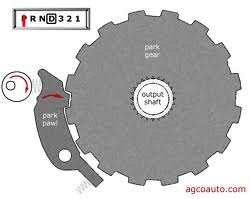
The parking brake will hold the car in place while it is parked and will help protect the transaxle, constant velocity joints, and transmission.
A parking brake is capable of a stronger hold than only putting the car in “park”, which of course you still need to do when you park your vehicle. Additionally, if your car was hit while parked, the parking brake would provide further stability, lessening the risk of your car rolling away. You should set the parking brake while your foot is still on the brake pedal and before shifting into park, this reduces the strain on the parking pawl.
Parking brakes can be hand-operated levers located in the center console, foot operated on the floor, sometimes on the dash and operated electronically in newer vehicles.
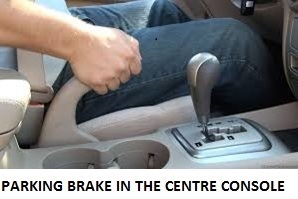
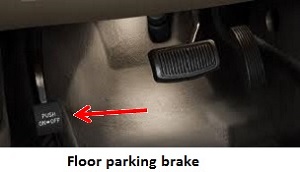
o set the hand operated parking brake, pull up on the lever and you will hear a clicking sound, to release the parking brake, press the button on the end of the brake handle and lower the lever. In vehicles where the parking brake is operated by foot, the pedal is located on the far left side of the driver’s pedal area. To set the brake, push firmly on the pedal with your foot until you hear it clicking.
Depending on your vehicle, there are a number of ways to release the parking brake on the floor. In some vehicles, the pedal is pushed again with your foot and is released; in other vehicles you must pull on a brake release lever located near the parking brake pedal; if in doubt check your owner’s manual.
Don't forget to disengage the parking brake before driving again, (see dashboard icon). It is obviously not good for your car and could be embarrassing for you. Setting the parking brake when you park and disengaging the parking brake before you drive should become a good habit, so you should never forget to do either part. Remember the old adage "If you don't use it, you will lose it"
Electronic Parking Brakes
Take a new luxury car out on the test drive and you'll probably notice one important difference as you're parking: The expected pedal or handbrake lever has been replaced by a single button or switch.
So what's the point? Actually it makes sense on many counts.These new electronic parking brake (EPB) systems, once you're used to them, are very convenient. There's no guessing whether it's properly engaged or not—that's all done by electronics, and all you need to do is switch it on or off. And yes, they operate independently of the primary braking system.
The idea was completely new when we first encountered an EPB in the 2002 BMW 7-Series, nearly ten years ago. That model marked the debut of the electronic parking brake in the U.S. market, with the 2003 Jaguar S-Type and 2003 Lincoln LS also among the first.
Now you're quite likely to see electric parking brakes when shopping; they're in everything from the 2011 Subaru Legacy to the 2011 Ford Mustang.
But deployment has been sluggish. According to TRW Automotive, just about ten percent of new cars in North America will have EPB systems by 2015.
They're catching on slower in the U.S. than in some other markets, such as Europe for one important reason: "In North America, adoption of this technology has lagged other regions primarily as a result of a higher percentage of automatic transmissions and drivers using their parking brake less often," said TRW Automotive in a recent release.
For those with a manual transmission, the electronic system automatically holds the vehicle in place and, in most cases, will release it when needed to allow a smooth start on a hill.
While it might sound more complex, electronic parking brakes save weight—up to 16 pounds versus a conventional drum-in-hat system. Fundamentally, it's also a simpler system, with fewer adjustments required and, says TRW, fewer warranty claims.
The only negative to this setup that we've seen is that manufacturers haven't been altogether consistent about how you engage and disengage the systems. Some are mounted on the center console, others on the dash—some in a place that requires craning your neck around the steering wheel to see it—and some you pull up or back to engage, others you push in.
Safety for emergency braking one other major advantage to EPB setups. Manual handbrake levers can lock up the rear wheels quite easily if you're attempting an emergency stop on anything but dry pavement. EPB mechanisms work with the anti-lock braking system, as the electronics are integrated—and it can even be configured to brake with all four wheels under emergency situations.
Another safety feature that's built into most EPB systems but isn't often touted is that they include an auto-apply feature: Say the driver steps out of the vehicle, thinking that the brake has already been applied, and the vehicle starts rolling. In that case, the parking brake automatically cinches up—and knows to because it's tied in with the door switch and seatbelt switches.
So if you have some hesitation in letting electronics do the work, keep in mind that someday they could save you.
Electronic Brake Monitoring
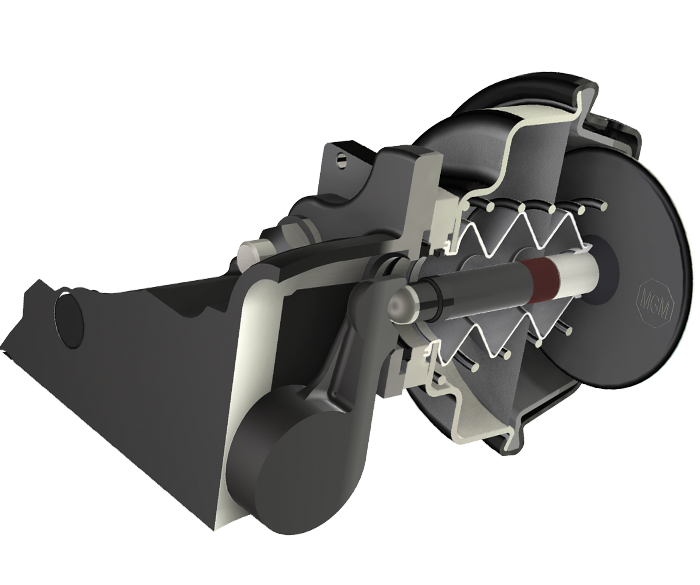
Verifying proper brake setup and operation on commercial drum and air disc brake equipped vehicles has historically been a significant problem in the industry. While daily pre-trip brake inspections are a CDL (Commercial Driver’s License) requirement, they are seldom performed due to the time and difficulty required to conduct these inspections. This has been historically true on drum brake equipped vehicles, and is even more of an issue on today’s air disc equipped vehicles.
Based on this need, MGM has designed and developed e•STROKE®, an electronic brake monitoring system for drum and air disc braked commercial vehicles. This system utilizes patented sensing technology to monitor brake stroke and convey this information to an electronic control unit (ECU) for analysis. This system can be utilized to assist in daily brake inspections, as well as provide continuous real-time brake monitoring on any air brake equipped vehicle.
These systems can detect the following braking issues or potential problems: improper automatic slack adjuster operation or maintenance, caliper internal adjuster mechanism failure (disc brakes), improper brake set-up or adjustment, air leaks or an improperly operating air system, defective air brake control valves, worn foundation components (i.e. worn bushings etc.), defective or worn spring parking brakes, and ice in the air system. brake brake to ENTERING ROBO SPRING
working ROBO SPRING :
ROBO SPRING in the science and technology of robo, vision, perception, control, automation, and machine learning. to be concern hail from a variety of engineering, scientific, and mathematical backgrounds, united by a passion for robo and a desire to advance robo technologies to benefit humanity. ROBO SPRING variety of industries including robo , aerospace, automotive, industrial automation and defense;

TRANSFORMROBO SPRING

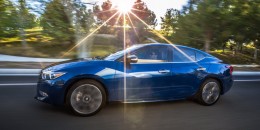




Tidak ada komentar:
Posting Komentar